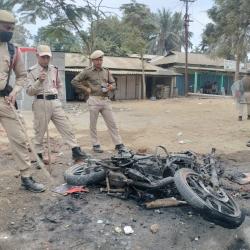Indian Rhino Vision 2020 misfires: another trans-located rhino dies
An ideal habitat for the breeding of rhinos, Kaziranga has seen a rise in the number of the species. The animal shrugged off its ‘endangered’ tag as soon as its population crossed the 2000 mark. This fuelled an overweening strategy--the much hyped Indian Rhino Vision -- that targeted 3,000 rhinos by the year 2020 in the rhino-bearing sanctuaries of Assam. However, with the number of this pre-historic pachyderm crossing the 2,500 mark, a host of challenges also came to the fore, poaching being only one of the concerns. Kaziranga has been plagued by other challenges like-- shrinking of the habitat, encroachment of the corridors around the Park, siltation of the water bodies and a complete lack of protection of the watershed of Kaziranga. The conservation of rhinos in Kaziranga started almost 110 years ago but conservation seems more in jeopardy now than it was a century back! With the growth of wild life population as well as the ever swelling human habitations in and around the Park, it has become a daunting task to meet these challenges without proper advisory and practice.
Instead of dealing with the long-term conservation challenges and preservation of this unique site, the Indian Rhino Vision only went on pulling out rhinos from Kaziranga and Pobitora for translocation solely keeping in view the magic figure of 3,000 rhinos by 2020. Manas National Park, another World Heritage Site and Laokhowa and Burhachapori Wildlife Sanctuaries remained preferred destinations for the translocation of rhinos under the IRV 2020 initiative. However, translocation to these wildlife areas remains a daunting task as these sanctuaries continue to be vulnerable. Rhinos were falling prey to poachers and the slaughter and maiming of the species continued unabated. Poaching of even trans-located rhinos overshadowed the whole IRV process.
Started on April 12, 2008, IRV's translocation process came under the scanner after more than half of the trans-located rhinos to Manas fall prey to the bullets of poachers. Without adequate patrolling staff, it was a colossal task for a few people to constantly guard the animals against human rapacity. The killing of these trans-located animals since 2011 in Manas World Heritage Site triggered the World Heritage Committee to send an alarm to the state that further deterioration of protection in Manas and subsequent damage caused to key attributes in Manas may lead to de-listing Manas from the World Heritage Site list.
Even after the debacle at Manas, the IRV stakeholders did not seem to learn the basics: to tighten up the protective mechanism in the sanctuaries that are soft targets for the poachers. They even went on for a temporary band-aid effort of "trimming" horns on rhinos to be trans-located to Burhachapori and also on stray rhinos. The decision, taken at the IRV 2020 partners meeting on January 30, 2014 at the Assam State Zoo was met with strong opposition from conservationists and the state forest department was compelled to abandon the idea.
Conservationists were of the view that security assessment is a must for translocation. The Assam Environment NGO Forum said—“If the government is unsure of the security in the targeted area, in this case Laokhowa and Burhachpori Wildlife Sanctuary, then translocation should be postponed till such time as the government is confident of its security apparatus.” But the stakeholders of IRV went on with their program of translocation and sent a mother rhino with its calf to the Boma (enclosure barricaded with thorny bushes and electric fence) in Burhachapori “to ensure success of translocation” that instead became the death knell for the duo.
An official of the Assam forest department, on conditions of anonymity, said, “Rhinos endure a certain amount of stress during the translocation process. It was a terrible sight-- when after regaining consciousness-- the mother rhino wounded itself with multiple injuries each time it stumbled on the thorny barrier in the effort to free itself from captivity. Further, the mother suffered a grave cut in the ear during notching, that turned septic and the animal died a slow and painful death last March. The orphaned calf was alone since March. The trauma the calf suffered after the ordeal it had gone through during the recent floods coupled with serious stomach ailments finally brought the end to the poor animal.” The rhino calf died.
Setback for IRV
The death of the rhinos in Burhachapori has become a huge setback for the IRV 2020 programme. There were allegations that the IRV stakeholders simply washed off their hands once translocation process was over; they were never bothered about the safety of the trans-located animals. This was indeed a grave allegation. The death of rhinos not only contradicts the conservation efforts but undoubtedly overshadowed the whole IRV process.
After the debacle at Burhachapori, many conservation NGOs of the state were seen protesting against the translocation programme of IRV. They held responsible the IRV stakeholders—Assam Forest Department, The Bodoland Territorial Council, International Rhino Foundation, US Fish and Wildlife Service and WWF--- for the death of at least 13 rhinos--those trans-located from Kaziranga and Pobitora. Kaziranga Wildlife Society, Early Birds, Aranya Suraksha Samity, Green Guard, The Green Society and Centre for Conservation, Education and Research demanded the forest department to stop the translocation process at once. The NGOs allege that translocation was carried out without prior and proper security arrangement of the targeted area. There were also severe allegations of negligence towards security and health monitoring of the animals. The NGOs further demanded the government to institute an inquiry into the death of all trans-located rhinos and at once make public the post mortem report of the female rhino died in the ‘Boma’ in Burhachapori last March.
Several student organizations including the Asom Jatiyatabadi Yuva Chatra Parishad also came out to voice their concern against killing of rhinos in the name of “translocation” under Indian Rhino Vision 2020---a policy that misfired!
Other Contents by Author
The debate how to allocate natural resources still raging, the northeastern states face more challenges—challenges posed by big dams and river linking. While the Union Government has turned its eyes to this most resource-rich landscape but largely untapped region in the country, communities now find themselves in a quandary. Communities want recognition of their ownership over coal, forests and oil--the three ‘nationalized’ resources. Now there is another entrant---water. Tribal communities in Nagaland and Meghalaya are approaching courts to protect their rights over oil and coal and those in Mizoram, Manipur and Arunachal Pradesh are struggling to retain control over their forests. In...
The Dibang movement fell silent as the Union Minstry of Environment and Forests granted clearance to the project last September after a reduction in the dam height by10 metres. After the Dibang it is now the Demwe Lower that is gathering storm in Northeast India.The 1,750-MW Demwe Lower mega hydel project—a 124-metre high dam proposed on the Lohit, a major tributary of the Brahmaputra in Arunachal Pradesh, has almost being pushed through had it not been for the Union Tourism and Culture Ministry’s objection that was the spanner at the last moment.Interestingly, the Union Ministry of Environment and Forests did not make any mention of the Central Tourism Ministry’s objection to the project...
Contrary to the popular belief that house sparrows are declining around the globe, the species seem to have adjusted to the changing environment. In Guwahati, the numbers of house sparrows have been growing by the day. Sparrow roost are now a common sight in different neighborhoods of the city. It is no more the Assam-type roofs or mud and thatch structures, the sparrows are now adaptating to the concrete structures in the urban areas.The documentary, I Spy Sparrows, tries to explores the reasons behind the increasing numbers of sparrows.
Known for its rich and unique biological diversity, Northeast India forms the core of the Eastern Himalaya Biodiversity Hotspot and is a World Wildlife Fund Global 200 Priority Ecoregion. Assam, one of the seven northeastern states, presents a landscape of lush evergreen forests and grasslands that is home to a great diversity of species including many of the rare cat species ranging from the magnificient tiger to the queen of the high mountains-- the snow leopard; the clouded leopard and the slinky common leopard--Panthera pardus. Of the magnificient felines--while the tiger enjoys the lion share of all conservation efforts, the leopard remains India's neglected big cat. Like all other...
The Great One Horned Rhinoceros is one of the rare and precious wildlife in the world and a state symbol of Assam. The poaching of this heritage species in the recent years in record numbers in its natural habitats, especially in Kaziranga, not only brought the animal to the edge but also created confusion among the public on the efficacy of the protection measures adopted by the forest department.A World Heritage Site and an ideal habitat for the breeding of rhinos, Kaziranga has seen a rise in the number of the species. The animal shrugged off its ‘endangered’ tag as soon as its population crossed the 2000 mark. This fuelled a overweening strategy--the much hyped Indian Rhino...
Erratic weather, floods and drought in the Himalayan foothills and a change in course of the river after the great earthquake of 1950, forced a group of people in the Murkongchelek area-- bordering Arunachal Pradesh-- to seek their fortune elsewhere. These agrarian people, belonging to the Mishing community, prefer to live by riverside as their occupations are directly related to the river. They crossed the Brahmaputra to settle on its southern bank and came upon an abode of nature surrounded by six rivers--Lohit, Dibang and Disang on the north and Anantanala, Dangori and Dibru on the south. A refuge for some rare and endagered wildlife, Dibru Saikhowa, on the Brahmaputra flood plain soon...
It was a joy ride from Darjeeling to Ghum. My co-passenger, a Mexican in his late sixties, was nodding playfully to the chug-chug of the doughty engine as the tom thumb coaches struggled uphill. His next destination, he said, would be Kaziranga. “Kaziranga! So you are visiting Assam?” — I was all ears to what he had to say about my home state.
“Assam! Where is it?”
One need not have to go through the geography of the land when it comes to Kaziranga--- I quickly tried to draw a conclusion.Kaziranga, or more precisely the Great One-horned Rhino, made the map of Assam more prominent in the World’s atlas. The pre historic pachyderm taking its trudge under...
The recent waves of floods have left a trail of devastation in the entire Brahmaputra valley. More than a week of heavy rains in Assam has caused the massive Brahmaputra to exceed dangerous levels. Smaller rivers have also over burst their banks. Twenty-six of the 27 districts in the state have been hit by floods since June 24 as a result of the unprecedented torrential rains while the Brahmaputra river has breached its banks in at least nine places. Nearly 200 people lost their life and millions affected. The agriculture sector suffered huge losses with 254,935 hectares of cropland damaged and 50% of crops destroyed.
The Kaziranga National Park, a World Heritage Site and the Dibru-...
While policy makers, experts , activists are converging on Rio for the UN conference Rio + 20 thousands of miles away in Assam (India)—22 farmers are languishing in the Lakhimpur jail for taking up cudgels to protect the environment. These poor farmers, supporters of the anti mega dam movement of Lakhimpur district, were arrested on the night of May 11, 2012 from the temporary camp of Krishak Mukti Sangram Samiti (the organization spearheading the anti big dam movement in northeast India) from Ghagarmukh nearing the dam site. While the traumatized families of these activists await their early release, the bail process seem complicated as they are being implicated on various false...
The term 'biodiversity' denotes the variability of life forms on earth. Each little life form has its own place, duty and specific utility that balances Nature beautifully. As such, ecosystem stability is a compelling reason for preserving biodiversity. All living organisms are an integral part of the biosphere. They provide invaluable services like recycling of nutrients, replenishment of local climate, control of floods and control of pests. The intervention or erosion of biodiversity means imbalance of nature. The Indian tradition teaches us that all forms of life--human, animal and plant--are so closely interlinked that disturbance in one gives rise to imbalance in the other.
The...










Comments
It's shocking that these
Pages
Add new comment